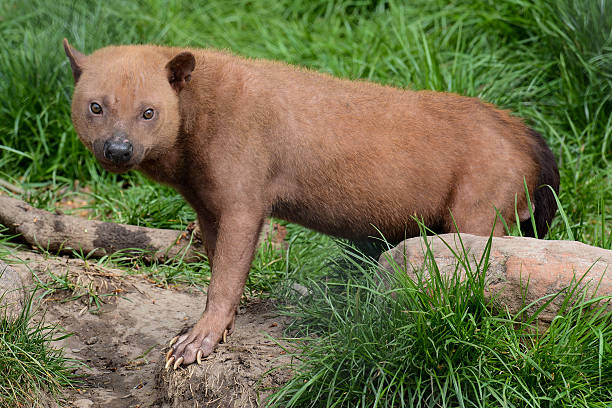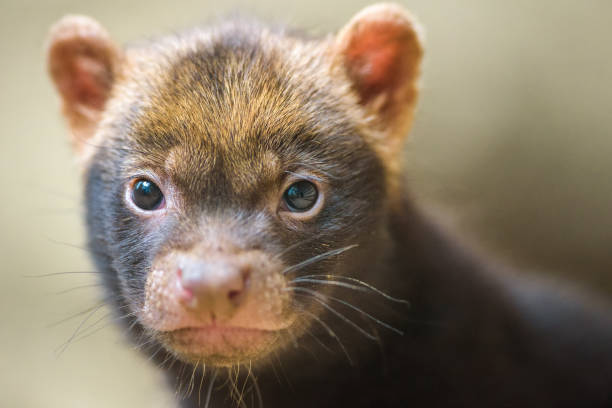Table of Contents
Scientific Classification
| Kingdom | Animalia |
| Phylum | Chordata |
| Class | Mammalia |
| Order | Carnivora |
| Family | Canidae |
| Genus | Speothos |
| Species | Speothos venaticus |
| Scientific Name | Speothos venaticus |
1. Description
The bush dog might not be the most famous member of the canine family, but it definitely deserves some attention. This carnivorous creature has short legs, a long body, and even webbed feet, giving it a look that’s more reminiscent of an otter than a traditional dog. Compact in size, it stands about 20–30 cm (8–12 inches) tall at the shoulders and weighs between 5–8 kg (11–18 lbs).
Its fur is thick and soft, coming in shades of reddish-brown or chocolate. The face is a lighter hue, while the back end is darker. With a bushy tail and small, rounded ears, bush dogs may not strike fear like wolves or foxes, but they are clever hunters. They thrive in packs and use teamwork to outsmart their prey.
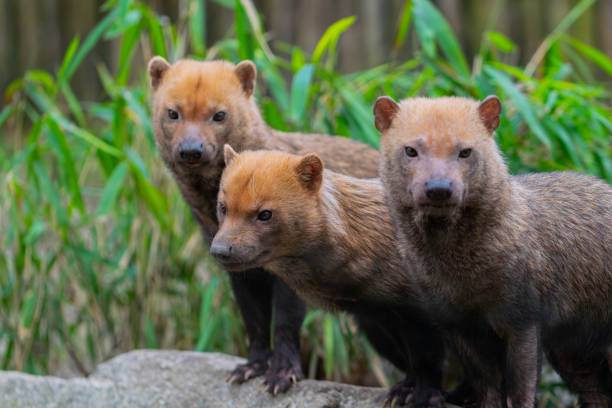
2. Distribution
Bush dogs are native to Central and South America, but spotting them can be quite a challenge since they’re pretty elusive and rare in their natural habitats. You can find populations in places like Panama, Venezuela, Colombia, Ecuador, Peru, Brazil, Paraguay, Bolivia, and northern Argentina. However, due to their secretive nature and fragmented habitats, actual sightings are few and far between, leaving a significant portion of their population unmonitored.
3. Habitat
These fascinating creatures prefer damp, wooded environments. They really flourish in tropical rainforests, savannas, and lowland forests. You’ll often spot them near water sources like rivers and swamps. Wetlands are particularly ideal for bush dogs, as their webbed feet make them excellent swimmers. They also inhabit seasonally flooded forests and gallery forests. Interestingly, they can adapt to disturbed areas, such as farmlands, as long as there’s enough cover and water available.
4. Diet
Bush dogs are true carnivores with a hearty appetite for medium-sized prey. Their menu typically features agoutis, pacas, armadillos, birds, rodents, and occasionally, reptiles and amphibians. As skilled pack hunters, they can take down animals much larger than themselves, like capybaras. They employ clever tactics to flush their prey out of hiding, sometimes even driving it into the water, where their impressive swimming skills give them the upper hand.
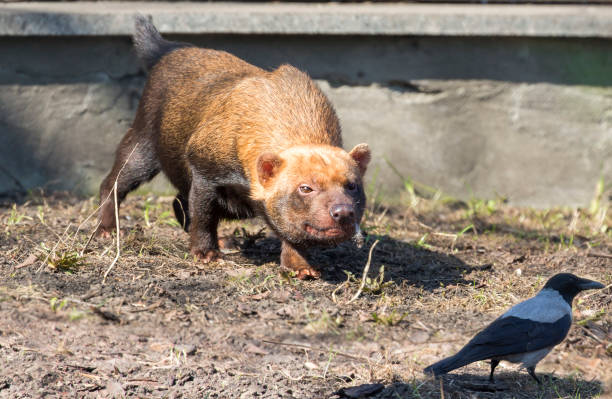
5. Behavior
Bush dogs are quite the mysterious creatures—shy and elusive, yet they have a remarkable knack for cooperation. They typically form small family groups or packs that can include up to 12 members. Within these packs, there’s a clear social structure, often led by a dominant alpha pair.
Their communication is fascinating, consisting of a mix of high-pitched whines, growls, and barks. When it comes to marking their territory, scent plays a crucial role; they use both urine and feces to establish their presence in an area.
These animals are crepuscular, meaning they’re most active during the early morning and late evening. However, depending on their environment, some groups might also be active during the day or even at night.
6. Lifespan
In the wild, bush dogs live about 6 to 10 years. In captivity, they may live longer. This is because they face fewer predators and have regular food and medical care. Many wild canines rely on a stable environment and no human threats for survival.
7. Reproduction and Lifecycle
Bush dogs usually breed just once a year, and it’s typically the alpha female who has the honor of giving birth to the pups. The entire pack pitches in to help raise the little ones. After a pregnancy that lasts about 65 days, she’ll have anywhere from 3 to 6 pups, usually in a cozy den that’s tucked away in thick vegetation or beneath tree roots.
When the pups arrive, they’re blind and completely dependent on their mother, but they grow quickly. Their eyes start to open around the two-week mark, and by the third week, they’re ready to try some solid food. By the time they hit 6 weeks, they’re curious enough to venture out of the den. It takes them several months to become fully independent, but they often stick around with the pack to help care for future litters.
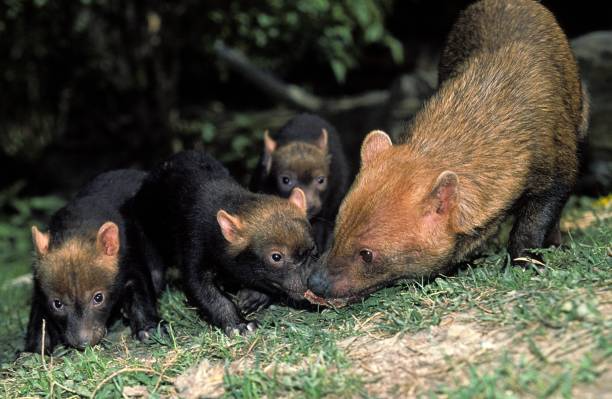
8. Predators
Bush dogs are on the smaller side, which puts them at risk from larger predators like jaguars, pumas, and big birds of prey. But interestingly, the most significant threat to bush dogs doesn’t come from these natural hunters—it’s actually human activities.
Things like deforestation, road construction, and farming have fragmented their habitats, making it increasingly difficult for these packs to maintain healthy populations.
9. Adaptations
The bush dog has developed special traits that help it live well in wet, forested areas:
- Webbed Feet: Their partly webbed feet help them swim, supporting their semi-aquatic nature. Bush dogs can chase prey through rivers and marshes. This makes them unique among canines.
- Pack Hunting: Bush dogs are small but hunt in groups. This helps them catch larger prey and makes hunting more efficient.
- Dense Fur: Their waterproof coat keeps them warm in cold water and wet places. This helps them stay active in swampy areas.
- High-pitched sounds help them hunt together. They also alert pack members to danger.
These traits make the bush dog a unique example of evolution in canids.
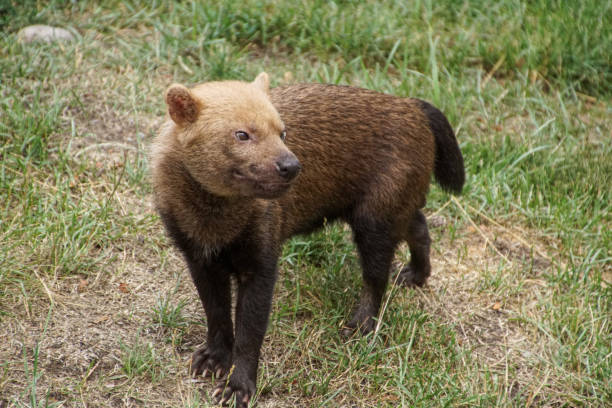
10. Conservation Status
According to the International Union for Conservation of Nature (IUCN), the bush dog is currently classified as Near Threatened, and unfortunately, its population is on the decline. The main culprit behind this drop is habitat destruction. Bush dogs require expansive territories and interconnected forest paths, so when these areas are fragmented, it severely impacts their ability to thrive.
Moreover, we don’t have a clear picture of their population numbers. This is largely because they’re elusive and tend to inhabit remote regions. The scarcity of data presents a significant hurdle for effective conservation planning.
To help protect bush dogs, several efforts are underway:
Habitat Protection: It’s crucial to preserve large forest areas and create safe corridors between fragmented habitats.
Research and Monitoring: We need to gather more information on bush dog behavior, population trends, and how they utilize their habitats.
Public Awareness: It’s important to educate local communities about the significance of forest ecosystems and the role carnivores like the bush dog play within them.
Unfortunately, captive breeding programs haven’t been very successful. Conservationists believe that in-situ conservation, which focuses on protecting species in their natural environments, is the most effective way to make progress.
Conclusion
The bush dog is one of those fascinating yet little-known members of the dog family. Despite its small size and tendency to blend into the background, it plays a crucial role in controlling prey populations and maintaining the balance of its ecosystem. With its unique adaptations and collaborative nature, this species truly stands out in the dense forests of South America.
Yet, without significant conservation efforts, the bush dog is at risk of disappearing altogether. To safeguard this elusive carnivore, it’s essential for researchers, policymakers, and the public to join forces. By doing so, we’re not just saving a species—we’re also protecting the entire forest culture that thrives alongside it.
